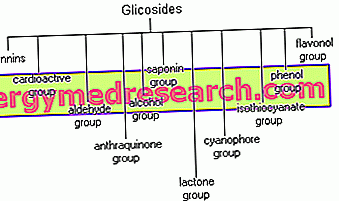Glycosides are a heterogeneous group of natural substances, widely distributed in nature and accumulated by a structure that sees bound together a sugary part, called glycoon, and a non-sugary part, called genin or aglycone. Also known as heterosides and with a remarkable pharmacological versatility, so complexed the glycosides behave like real pro-drugs: once they are in fact they undergo enzymatic hydrolysis processes that separate the sugar part from the aglycon. The latter generally represents the pharmacologically active fraction of the molecule; the sugary part, however, contributes to modulating its intensity of action, its toxicity and the solubility of the entire molecule; glycon, for example, is essential for the accumulation of essential oils (hydrophobic) in the aqueous compartment of vacuoles.
Glycosides can be classified based on:
1) to the sugary part (glucose, fructose, rhamnose, galactose or arabinose);
2) to the part representing the aglycone (the various secondary metabolites);
3) the type of bond that holds the aglicone together with the non-sugary part;
4) to the physical or pharmacological properties of glycoside;
1) On the basis of the sugary part that characterizes them, for example, glycosides can be classified into glucosides (glycon = glucose), fructosides (glycon = fructose), ramnosides (glycon = rhamnose), galactosides (glycon = galactose), arabinosides ( glicone = arabinose), steviosidi (glicone = steviolo) etc .. If instead the sugary part is composed of more sugars, these must all be named; thus, for example, we will talk about ramnoglucoside in reference to a generic glycoside containing a glycon composed of rhamnose and glucose.
2) To highlight the type of aglycon present in the glycosidic molecule, suffixes such as antachinon- (aglycone = anthraquinone), phenol- (aglycone = phenol), flavonol- (aglycone = flavonol), cumarin- (aglycone = coumarin) are used, sterol- (aglycon = sterol) etc. Other times it is preferred to use the relative attribute, for example anthraquinone glycoside (aglycone = anthraquinone) etc.
3) With reference to the type of bond that holds the aglycon together with the non-sugary part we speak of O-glycosides (sugar bound to the aglycon through an oxygen atom), S-glycosides (sugar bound to the aglycon through an atom of sulfur), C-glycosides (sugar bound to the aglycon through a carbon atom) and N-glycosides (sugar bound to the aglycon through a nitrogen atom).

Given the extreme variability of chemical-physical properties and pharmacological activities, the classification of glycosides is often entrusted to the nature of the functional part (aglycon).

Examples of glycosides and in-depth articles
ANTHRACHINONIC GLYCOSIDES: glycosides containing aglycones structurally related to the anthracene molecule; this is the case of the senna sennosides, endowed with a powerful laxative effect.
CARDIOACTIVE GLYCOSIDES: glycosides with a powerful and specific action on the heart; is the case of digitoxin contained in the digital (cardiotonic effect).
CYNOGENETIC GLYCOSIDES: glycosides which, by hydrolysis, liberate hydrocyanic acid, with extremely toxic effects but with potential anticancer activity; this is the case of the amygdalin contained in the bitter almond.
PHENOLIC GLYCOSIDES: the best known is arbutin of bearberry, used in phytotherapy against cystitis and bacterial urethritis due to its antiseptic properties on the urinary tract.
FLAVONIC GLYCOSIDES: the aglycone is a flavonoid; we remember, for example, the rutin, characteristic of the Ruta, with vasoprotective effect, whose aglicone is represented by the flavonoid quercetin.
SALICYL GLYCOSIDES: the salicin extracted from the bark of the willow or from the spirea olmaria is known for its analgesic, antirheumatic and antipyretic effects; not by chance is the basis for the production of the famous Aspirin.
SOAP GLYCOSIDES: the licorice glycerine has gastroprotective, antiulcer and hypertensive properties; ginseng ginsenosides have an adaptogenic effect.



